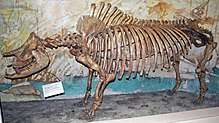Aphelops
Aphelops is an extinct genus of hornless rhinoceros endemic to North America. It lived from the Middle Miocene to the early Pliocene, during which it was a common component of North American mammalian faunas along with Teleoceras.[1]
| Aphelops | |
|---|---|
 | |
| Skeleton in Nebraska State Museum of Natural History | |
| Scientific classification | |
| Kingdom: | Animalia |
| Phylum: | Chordata |
| Class: | Mammalia |
| Order: | Perissodactyla |
| Family: | Rhinocerotidae |
| Subfamily: | †Aceratheriinae |
| Genus: | †Aphelops Cope, 1874 |
| Type species | |
| Aceratherium megalodum Cope, 1873 | |
| Species | |
| |
Description

On the basis of skull size, the largest species of Aphelops is A. mutilus (which is the largest North American rhinoceros)[2] and the smallest is the type species A. megalodus.[3] A. mutilus has been estimated to have weighed 764–1,762 kilograms (1,684–3,885 lb),[4] and A. malacorhinus has been estimated at 889 kilograms (1,960 lb).[5]
Aphelops can be distinguished by other members of the Aceratheriinae by two traits: the arched top of the skull, and the long diastema (gap) between the second incisor (lower tusk) and first premolar. Many other aspects of its anatomy are typical of aceratheriines, including: the absence of a horn on the broad, unfused nasal bones; the reduced premaxilla and lost first incisor; a nasal incision (or notch below the nasal bones) reaching at least the level of the fourth premolar; a triangular-shaped skull when viewed from the rear; narrow zygomatic arches; brachydont or low-crowned teeth without cement; upper molars bearing a fold of enamel known as an anterocrochet; and lower tusks that are subcircular in cross-section.[3]
More derived (specialized) species have larger teeth and longer, more slender nasal bones (also producing a larger incision). The various species also differ in the depth of the nasal incision: in A. megalodus, it reaches the front of the fourth premolar; in A. malacorhinus, it reaches the rear of that tooth; and in A. mutilus, it reaches the first molar.[3][2]
Palaeobiology
The lower tusks of Aphelops are informative about the sex and age of individuals, as in Teleoceras: males have much thicker tusks,[6][7] while older individuals have more strongly erupted tusks showing more extensive wear patterns. The stages in the eruption of the molar-like cheek teeth were identical to living rhinos. These factors were used by Matthew Mihlbacher in 2003 to analyze a bone bed of Aphelops known as the Love Island bonebed; adults (between 35% and 68% of maximum lifespan) are most common, there appears to be no male bias, and young males are rare. This is unlike Teleoceras, where young males are disproportionately preserved in bone beds. Such a difference may imply different social behaviour: young male Aphelops perhaps died less frequently from fighting, and used different kinds of ritualistic displays. Aphelops were probably not completely monogamous, with the degree of sexual dimorphism being suggestive of polygyny.[6]
Palaeoecology
Aphelops is thought to have been a browser on C3 plants, like the modern black rhinoceros, with its longer limbs adapted to traversing open, brushy country. Isotopic evidence suggests that, in the late Miocene, Teleoceras had limited intake on newly-emergent C4 grasses, but Aphelops continued to browse.[5][1] This difference in feeding ecologies explains how they could coexist sympatrically across many environments for 13 million years. Both went extinct at the end of the Hemphillian North American land mammal age, most likely due to rapid climate cooling, increased seasonality and expansion of C4 grasses.[1]
References
- Wang, B.; Secord, R. (2020). "Paleoecology of Aphelops and Teleoceras (Rhinocerotidae) through an interval of changing climate and vegetation in the Neogene of the Great Plains, central United States". Palaeogeography, Palaeoclimatology, Palaeoecology. 542: 109411. Bibcode:2020PPP...542j9411W. doi:10.1016/j.palaeo.2019.109411.
- Tanner, L.G. (1967). "A New Species of Rhinoceros, Aphelops kimballensis, from the Latest Pliocene of Nebraska". Bulletin of the University of Nebraska State Museum. 6 (1).
- Prothero, D.R.; Manning, E.M. (1987). "Miocene Rhinoceroses from the Texas Gulf Coastal Plain". Journal of Paleontology. 61 (2): 407–409. doi:10.1017/S0022336000028559. JSTOR 1305331.
- Lambert, W.D. (2006). "Functional Convergence of Ecosystems: Evidence from Body Mass Distributions of North American Late Miocene Mammal Faunas". Ecosystems. 9 (1): 116. doi:10.1007/s10021-005-0076-8.
- MacFadden, B.J. (1998). "Tale of two Rhinos: Isotopic Ecology, Paleodiet, and Niche Differentiation of Aphelops and Teloceras from the Florida Neogene". Paleontology. 24 (2): 274–286. JSTOR 2401243.
- Mihlbachler, M.C. (2003). "Demography of late Miocene rhinoceroses (Teleoceras proterum and Aphelops malacorhinus) from Florida: linking mortality and sociality in fossil assemblages". Paleobiology. 29 (3): 412–428. doi:10.1666/0094-8373(2003)029<0412:dolmrt>2.0.co;2.
- Mead, A.J. (2000). "Sexual dimorphism and paleoecology in Teleoceras, a North American Miocene rhinoceros". Paleobiology. 26 (4): 689–706. doi:10.1666/0094-8373(2000)026<0689:SDAPIT>2.0.CO;2.